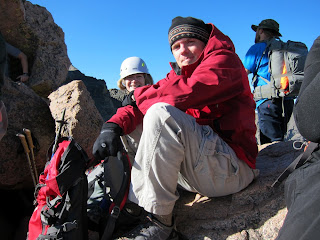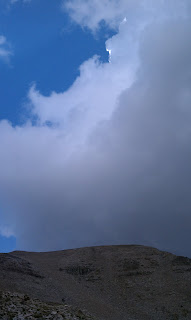I continued on nonetheless, but put on a balaclava and glacier glasses in anticipation of the winds I would soon encounter. Right on cue, the exit from treeline to exposed snow packed tundra was greeted with cold icy blasts blowing down from the Continental Divide. My lower and upper body were covered with layers of Cap 3 and Gore-Tex, and proved to be quite adequate in preserving warmth. In addition, a wool hat and the balaclava provided plenty of protection for my head and neck. However, the pair of First Ascent Guide Gloves were not enough protection to prevent my hands/fingers from becoming numb. In hindsight, I should have brought along a pair of heavy mitts (stupidly I left them in the truck to save weight). I also had issues with the pair of Julbo Explorer glacier glasses...moisture emanating from my balaclava combined with the cold ambient temperature led to annoying lens fog-up.
Besides a few gear issues, the combination of a steep snow packed slope exposed to the strong downslope winds made it nearly impossible to maintain upward progress. In fact, I fell down several times, sliding back down the slope in multiple awkward positions. So, hands were becoming numb (would frostnip/bite be next?), and the winds were knocking me down (and would surely be worse at the top of the Divide)...I decided the responsible thing to do was admit defeat and come back another day. The other day could have been the following one, except a blizzard was taking aim on New Mexico, the Texas Panhandle, and Kansas, which would block my return route to Oklahoma (or even worse, cause me to become stranded). I had no choice but to start driving back home after my summit attempt...this trip was an epic fail.





















































